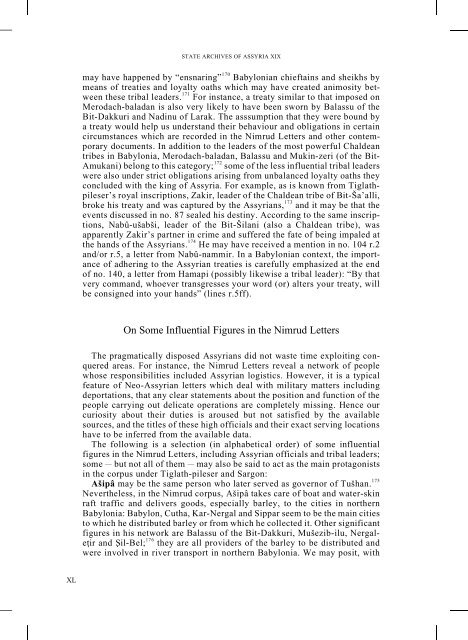Download PDF version of SAA 19 introduction - UCL
Download PDF version of SAA 19 introduction - UCL
Download PDF version of SAA 19 introduction - UCL
You also want an ePaper? Increase the reach of your titles
YUMPU automatically turns print PDFs into web optimized ePapers that Google loves.
STATE ARCHIVES OF ASSYRIA XIX<br />
may have happened by “ensnaring” 170 Babylonian chieftains and sheikhs by<br />
means <strong>of</strong> treaties and loyalty oaths which may have created animosity between<br />
these tribal leaders. 171 For instance, a treaty similar to that imposed on<br />
Merodach-baladan is also very likely to have been sworn by Balassu <strong>of</strong> the<br />
Bit-Dakkuri and Nadinu <strong>of</strong> Larak. The asssumption that they were bound by<br />
a treaty would help us understand their behaviour and obligations in certain<br />
circumstances which are recorded in the Nimrud Letters and other contemporary<br />
documents. In addition to the leaders <strong>of</strong> the most powerful Chaldean<br />
tribes in Babylonia, Merodach-baladan, Balassu and Mukin-zeri (<strong>of</strong> the Bit-<br />
Amukani) belong to this category; 172 some <strong>of</strong> the less influential tribal leaders<br />
were also under strict obligations arising from unbalanced loyalty oaths they<br />
concluded with the king <strong>of</strong> Assyria. For example, as is known from Tiglathpileser’s<br />
royal inscriptions, Zakir, leader <strong>of</strong> the Chaldean tribe <strong>of</strong> Bit-Ša’alli,<br />
broke his treaty and was captured by the Assyrians, 173 and it may be that the<br />
events discussed in no. 87 sealed his destiny. According to the same inscriptions,<br />
Nabû-ušabši, leader <strong>of</strong> the Bit-Šilani (also a Chaldean tribe), was<br />
apparently Zakir’s partner in crime and suffered the fate <strong>of</strong> being impaled at<br />
the hands <strong>of</strong> the Assyrians. 174 He may have received a mention in no. 104 r.2<br />
and/or r.5, a letter from Nabû-nammir. In a Babylonian context, the importance<br />
<strong>of</strong> adhering to the Assyrian treaties is carefully emphasized at the end<br />
<strong>of</strong> no. 140, a letter from Hamapi (possibly likewise a tribal leader): “By that<br />
very command, whoever transgresses your word (or) alters your treaty, will<br />
be consigned into your hands” (lines r.5ff).<br />
On Some Influential Figures in the Nimrud Letters<br />
The pragmatically disposed Assyrians did not waste time exploiting conquered<br />
areas. For instance, the Nimrud Letters reveal a network <strong>of</strong> people<br />
whose responsibilities included Assyrian logistics. However, it is a typical<br />
feature <strong>of</strong> Neo-Assyrian letters which deal with military matters including<br />
deportations, that any clear statements about the position and function <strong>of</strong> the<br />
people carrying out delicate operations are completely missing. Hence our<br />
curiosity about their duties is aroused but not satisfied by the available<br />
sources, and the titles <strong>of</strong> these high <strong>of</strong>ficials and their exact serving locations<br />
have to be inferred from the available data.<br />
The following is a selection (in alphabetical order) <strong>of</strong> some influential<br />
figures in the Nimrud Letters, including Assyrian <strong>of</strong>ficials and tribal leaders;<br />
some — but not all <strong>of</strong> them — may also be said to act as the main protagonists<br />
in the corpus under Tiglath-pileser and Sargon:<br />
Ašipâ may be the same person who later served as governor <strong>of</strong> Tušhan. 175<br />
Nevertheless, in the Nimrud corpus, Ašipâ takes care <strong>of</strong> boat and water-skin<br />
raft traffic and delivers goods, especially barley, to the cities in northern<br />
Babylonia: Babylon, Cutha, Kar-Nergal and Sippar seem to be the main cities<br />
to which he distributed barley or from which he collected it. Other significant<br />
figures in his network are Balassu <strong>of</strong> the Bit-Dakkuri, Mušezib-ilu, Nergaleṭir<br />
and Ṣil-Bel; 176 they are all providers <strong>of</strong> the barley to be distributed and<br />
were involved in river transport in northern Babylonia. We may posit, with<br />
XL

















